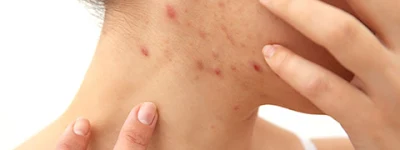SWEET SYNDROME KI ETIOLOGY (KAARAN):
1. Classic ya Idiopathic Sweet Syndrome: Yeh sabse common type hai, jismein 71% cases aate hain. Isme koi clear underlying condition nahi hoti hai. Pregnancy se related lagbhag 2% cases hote hain.
2. Malignancy-Associated Sweet Syndrome: Yeh zyada tar hematologic cancers se linked hoti hai, jaise acute myeloid leukemia. Dusre cancers, jaise genitourinary, breast, aur gastrointestinal cancers bhi link ho sakte hain.
3. Infection-Related Sweet Syndrome: Bacterial infections (jaise Streptococcus pneumoniae, Staphylococcus, Salmonella), fungal infections (jaise coccidioidomycosis), aur viral infections (HIV, hepatitis, CMV) isse related ho sakti hain.
4. Drug-Induced Sweet Syndrome: Kuch medications jaise G-CSF, all-trans retinoic acid (ATRA), aur trimethoprim-sulfamethoxazole se bhi yeh syndrome ho sakta hai. Kai aur drugs, jaise antibiotics, immunosuppressants, aur vaccines bhi implicated hain.
5. Systemic Disorder-Related Sweet Syndrome: Crohn’s disease, ulcerative colitis, Sjögren's syndrome, lupus, aur rheumatoid arthritis jaise inflammatory diseases se bhi yeh syndrome linked hota hai. 16% cases mein yeh condition hoti hai.
6. Miscellaneous Causes: Surgery ke baad, transplant patients mein, aur HIV patients mein immune reconstitution inflammatory syndrome (IRIS) ke part ke roop mein Sweet Syndrome report kiya gaya hai. Radiotherapy bhi implicated hota hai.
SWEET SYNDROME KI EPIDEMIOLOGY (JIS TARAH SE YEH HOTA HAI)
Frequency: Sweet syndrome uncommon hai, lekin rare nahi. Lagbhag 10-20% cases malignancies se linked hote hain, par zyada tar idiopathic ya benign conditions se related hote hain.
Sex:
- Classic/Idiopathic Sweet Syndrome: Zyada tar females mein hota hai, jaha female-to-male ratio 3:1 se 8:1 hota hai.
- Drug-Induced Sweet Syndrome: Isme bhi zyada females affect hoti hain.
- Malignancy-Associated Sweet Syndrome: Isme gender ka koi preference nahi hota.
- Children: Bacchon mein bhi yeh sex ka farq nahi dikhata.
Age: Zyada tar 30-50 saal ki mahilayein isse affected hoti hain. Bacchon mein yeh rare hota hai, aur infection ya kabhi kabhi cancer se linked hota hai. 5 din ke neonates tak mein cases report kiye gaye hain.
SWEET SYNDROME KA PROGNOSIS
Zyada tar Sweet Syndrome cases resolve ho jaate hain, lekin kuch cases mein yeh persist kar sakte hain, jisse pain aur skin breakdown ho sakti hai. Prognosis heavily underlying cause par depend karta hai, khaaskar malignancies ya drug reactions se associated cases mein. 50% tak patients mein recurrence hota hai, khaaskar jinhe hematologic malignancies hoti hain.
CLINICAL HISTORY
Zyada tar cases mein fever skin lesions ke aane se kuch din ya weeks pehle hota hai, par kabhi kabhi yeh ek sath bhi ho sakte hain. Bahut se patients ek recent upper respiratory infection, tonsillitis, ya flu-like illness ke 1-3 hafte baad skin lesions ko report karte hain. Recent vaccination ya gastrointestinal infection bhi eruptions se pehle ho sakti hai. Lesions, jo generally achanak aate hain, agar untreated rahein toh kuch din se mahino tak reh sakte hain.
PHYSICAL EXAMINATION OF SWEET SYNDROME
Cutaneous Manifestations:
· Lesions: Bright-red, reddish-blue, ya violet papules, plaques, ya nodules hote hain, kabhi kabhi yeh vesicular lagte hain due to subepidermal edema. In pustules mein ekathe ho kar circinate ya arcuate plaques ban jaate hain.
· Location: Yeh commonly face, neck, aur extremities ko affect karte hain asymmetrical pattern mein.
· Characteristics: Lesions painful aur burning hoti hain, lekin itchy nahi hoti, aur bina scarring ke resolve ho jaati hain.
· Specific Sites:
o Hands: Lesions symmetrically distributed hoti hain fingers aur hands ke dorsal aspects par.
o Oral/Ocular Mucosa: Oral lesions hematologic disorders mein common hoti hain. Ocular manifestations mein conjunctivitis, episcleritis, uveitis aur eye inflammation shamil hain.
Outside the Skin:
· Lungs: Yeh shortness of breath, chronic cough, ya lungs mein fluid jaise symptoms cause kar sakte hain.
· Kidneys: Yeh protein ya blood in urine, ya creatinine levels mein drop jaise problems cause kar sakte hain.
· CNS: Brain aur nerves affect hote hain jaise encephalitis, meningitis, headaches, confusion aur seizures.
· Other Organs: Bones, digestive system, joints, liver, heart, muscles aur spleen ko affect kar sakte hain.
Reaction to Injury:
Lesions: Chhoti chhoti ghaav ya zakhm un jagah par ban sakte hain jahan chhoti chhoti chot lagi ho, yeh kuch pyoderma gangrenosum jaisi condition se milti-julti hoti hai.
Underlying Conditions & Pregnancy:
Sweet syndrome kuch doosri bimariyon jaise cancer ya systemic issues ke saath linked ho sakti hai. Cause pata karne ke liye kuch imaging tests karwani pad sakti hai. Agar kisi pregnant woman ko Sweet syndrome ho, to aane wali pregnancies mein wapas aa sakta hai, lekin yeh baby ko usually nuksaan nahi pahunchaata.






No comments:
Post a Comment